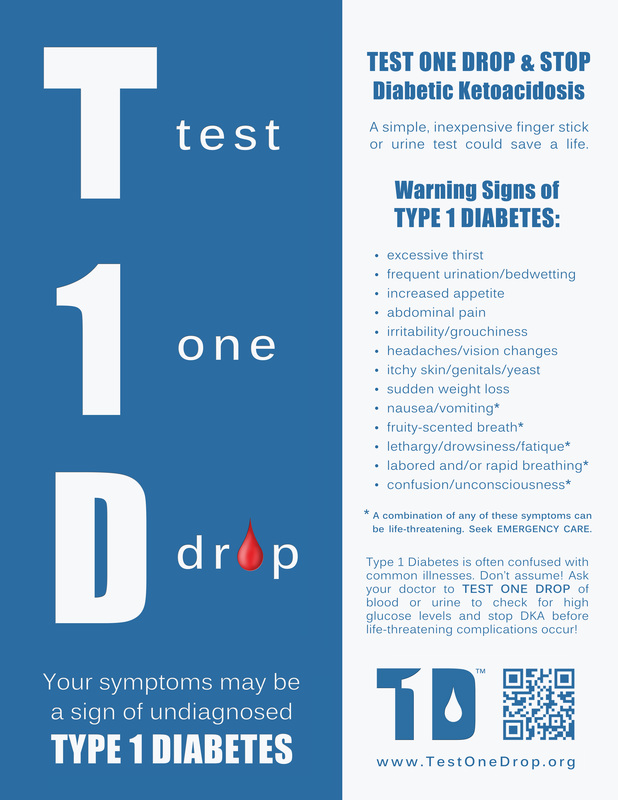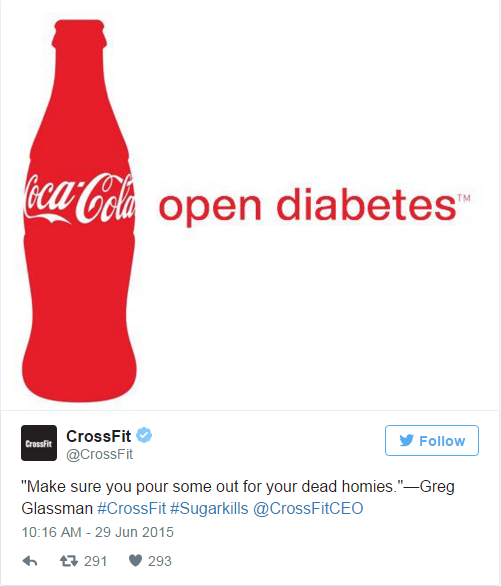People can LIVE with type 1 diabetes, but they have to know they have it! That diagnosis is life-saving. It’s crushing…it’s heart-breaking…it’s a blow that’ll drop you to your knees. But it also saves a life. At the time of diagnosis, a person with type 1 diabetes is in a state of hyperglycemia. Too much sugar in their blood. It’s fixable, with insulin, but it has to be correctly diagnosed. There are a lot of warning signs:
- extreme thirst
- frequent urination
- sudden weight loss
- increased appetite
- fruity odor on breath
- nausea or vomiting
- wetting the bed in a child who previously wasn’t
- extreme headaches
- extreme irritability
- drowsiness or lethargy
- heavy-labored breathing
- sudden vision changes
- weakness or confusion
- stupor or unconsciousness
If you notice one or two of these in someone you love, please do something about it. Mackenna did not exhibit every one of these symptoms. I only noticed two. But those two symptoms jogged my memory of my brother’s type 1 diagnosis back in 1994. Within an hour of me connecting my observations with Mackenna to my memory of my brother, we were at the clinic receiving the diagnosis I hoped I was wrong about. (Read her diagnosis story here.) What if I waited? What if I ignored my instinct? What if I didn’t have those memories? What if I didn’t recognize those symptoms for what they were? I can’t go there in my mind. Instead, I thank the Lord for His timing, His mercy, His goodness. We caught it early. But for some kids, it’s caught too late.
In July, the type 1 diabetes community was crushed when one of our own lost her fight. Kycie Terry passed away at age 5 after a misdiagnosis a few months beforehand. Her doctors thought she had strep, maybe the flu, and they sent her home with antibiotics. She’s not the first kiddo, and won’t be the last who passes away because of a misdiagnosis. Her parents did everything right. They took her in. They trusted the medical staff. They followed doctors’ orders and took her home to administer antibiotics for strep. But the doctors had it wrong and by the time they realized it was actually type 1 diabetes, she had suffered brain damage.
Know the warning signs.
If your child is showing some, trust your gut. Rule out type 1 at your doctor’s office. It is a very simple test with either a urine or blood sample. If they look at you like you’re crazy, tell them you are…you’re crazy about your kid. And if they still won’t do it, call me, or anyone you know with type 1 diabetes because they’ll be able to test for you at home.
And spread the word! Because in the case of type 1 diabetes, what you don’t know CAN kill you.
  Learn more here: http://www.testonedrop.org/
Since Mackenna’s pancreas isn’t doing its job of balancing carbs and insulin (read more about that here), we need to constantly monitor how much sugar is in her blood. This helps us know whether she needs more carbs, more insulin, or neither. Our main method of monitoring is through finger pokes.
A person with type 1 diabetes should check their blood sugar with a finger poke before eating and before going to sleep at night. Since Mackenna doesn’t always feel the symptoms of high or low blood sugars, she averages about 10 finger pokes each day…always before eating and before going to sleep, but also before playing at the park, at halftime of her soccer games, before and after Phy Ed at school, before getting on the bus to come home from school, before going to a playdate…or any other time we are needing to keep a closer eye on her.
So about 10 times a day, the skin on her little fingers is punctured. A little blood is squeezed out, to give us the information we need in order to keep her safe.
The question most people ask about finger pokes, kids and adults alike, is “Does it hurt?”
Her answer: “No!”
My answer: “Yes!” It hurts just a little bit, like a mosquito bite. I know because every once in a while she wants to check my blood sugar and I can’t say no to that! It stings for just a second. But she’s used to it. And her little fingers are rough and calloused now, a little padding to ease the pain.
She and I recorded this video a year ago today. She’s demonstrating how to do a finger poke. She was 6 years old at the time.
Watching that video makes me teary-eyed. Because I was there when she had her first finger poke, and her second, and third. I was the one holding her flailing limbs down so the nurse could grab her hand long enough to administer the poke. I was there to hold her and hug her and wipe her tears away. And I held my breath every three hours because I knew what she didn’t: the nurse was on her way in for another poke. But look at that girl in the video! There’s no fear. There’s no anxiety. There’s just strength and courage and confidence. My goodness, I love that God chose me to be her mommy!
For those of you who have been reading the blog all week…learning a little more about type 1 diabetes…Thank you! Really! It means so much that you’re taking the time to do that. I hope you’ve learned something new. I’ve got more posts planned for next week!
If you’re wearing blue today to spread awareness, don’t forget to take a picture and use the hashtag #onfridayswewearblue! Mackenna will be so excited to see who’s supporting her!
President Obama recently referenced diabetes when trying to make a point about something completely unrelated to the disease.
“If you go to 100 doctors, and 99 of them tell you have diabetes, you wouldn’t say, ‘Ah, that’s a conspiracy. All 99 doctors got together with Obama to keep me from having bacon and donuts,’” he joked. “You wouldn’t do that.”
He basically reiterated the myth that diabetes is caused by unhealthy eating habits. Bacon and donuts. Even if he was referring to type 2 diabetes, which can be affected by diet, why is it ok for any disease to be the butt of a joke? Why would the leader of our entire country throw a comment like that out so flippantly? It’s irresponsible. It’s ignorant. And it’s not the first time.
In June, the CEO of CrossFit posted this image on twitter, causing quite a controversy. He was barraged on social media for the inaccuracy of his message and proceeded to defend himself anyway.
 
And I cannot tell you how many times I have seen this “joke” float around on social media.
.jpg) 
AH! No! Billy cannot get diabetes from eating 28 candy bars! If you that is news to you, please take a moment to read these posts about how someone gets type 1 diabetes, and what people with diabetes can eat! The correct answer to that math problem is 4. Just 4. Billy has 4 candy bars, not diabetes!
 
It’s confusing to me why it’s alright to make a disease the butt of a joke. There are no jokes about cancer. There are no jokes about arthritis, multiple sclerosis, AIDS. Why diabetes? I’ll tell you why. Because it isn’t understood. People actually think that diabetes is caused by eating bacon and donuts and drinking coca cola! Diabetes research is underfunded because people think it’d go away with diet and exercise. Underfunded means my sweet girl, and millions of others, are waiting TOO LONG for a cure!
That’s why there’s Diabetes Awareness Month. That’s why there’s World Diabetes Day (November 14th). That’s why I’m going to post and Instagram and blog about it all month. That’s why we wear blue on Fridays. Because we need to get some attention on this disease.
Tomorrow is the first Blue Friday of Diabetes Awareness Month of 2015. We’ll all be wearing blue for Mackenna. For her Uncle Josh. For her friends from camp. Because we love them. Because we’re committed to correcting misconceptions and educating whoever will listen. Because the world should know the truth about their disease. Because we need a cure!
Will you wear blue on Friday with us? If you post a picture on social media, use the hashtag #onfridayswewearblue and I’ll be sure to show it to Mackenna.
What is type 1 diabetes? How did she get it? Those are some other great questions I get. They are big questions, with big answers…but I’m going to give them a shot.
You have a pancreas. So does Mackenna. When you eat or drink anything with carbohydrates, your body turns those carbs into sugar and deposits it into your blood stream. That sugar is the fuel your body needs to think and move. But your body can’t use that sugar if it’s sitting in your blood. It needs to get into your cells in order to be useful. This is where your pancreas comes in really handy! Your pancreas has specialized cells called beta cells that make a hormone called insulin. And insulin is the key that unlocks the cell doors so that the sugar can enter and provide energy so your body can function.
The beta cells in Mackenna’s pancreas have stopped making insulin. That is type 1 diabetes. When a person is first diagnosed with T1D, their blood is full of sugar because without insulin, there’s been no way for the sugar from their food to exit the blood stream. If a person goes without insulin for too long, all that sugar stuck in the blood can actually make their blood turn acidic. This is called diabetic ketoacidosis and can be fatal. A person with type 1 diabetes must inject insulin through needles or an insulin pump.
Unfortunately, I don’t have a great answer for the “How did she get it?” question. I can tell you this for certain: there is nothing that she did or we did to cause it, and there is nothing we could have done to prevent it. Mackenna did not eat too much sugar. She is not overweight. She exercises as much or more than any other typical child does. T1D is an autoimmune disorder which means that the body attacks itself. There’s a bit of a genetic component to it, but having T1D in your family does not mean someone else will end up having it…and not having T1D in your family doesn’t mean no one in your family will end up having it.
Our journey with diabetes has taught me a lot of things. But very early on after Mackenna’s diagnosis, one of the things that really hit me was just how detailed our Creator is. Understanding what I do now about carbohydrates, beta cells, insulin, blood sugar numbers, I am blown away with how complicated it is! One little part of my daughter stopped working. Her pancreas quit. I spend my days and nights trying to take its place and it is HARD WORK! I’m a pretty smart gal; I can crunch numbers and identify patterns and learn new strategies. But I am not a pancreas. And I am not even close to almost-as-good-as a pancreas. That He would put that much thought and detail and purpose into one of our lesser-talked-about organs is astounding to me. That for most people, it works beautifully, and they never have to think about it because of its perfect design is amazing! So if you do not have type 1 diabetes, thank your pancreas! It works hard for you and hardly gets any credit for keeping you alive! But better yet, thank the One who made it!
 
« Older posts
Newer posts »
|
.PNG)
.jpg)


.jpg)



